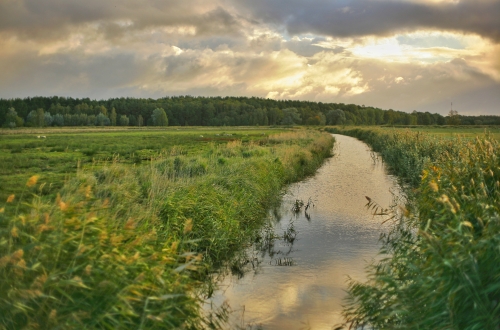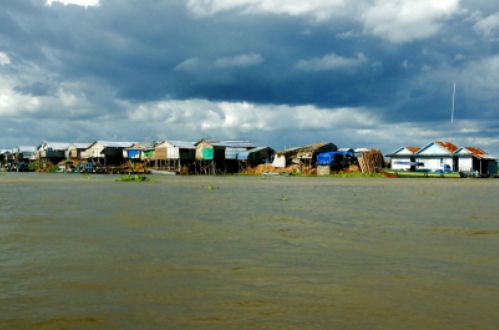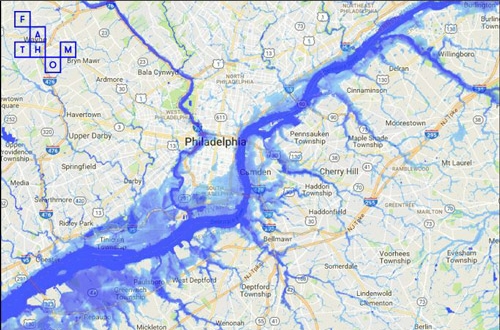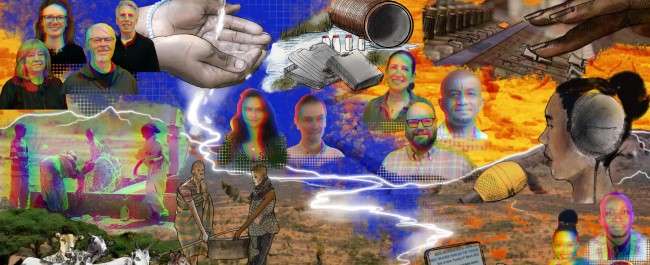Water
We are transforming the evidence base for water-based decision making in a changing and deeply uncertain world.
Contact the water research leads
Dr Katerina Michaelides (hydrology, geomorphology, drylands)
Dr Rafael Rosolem (hydrometerology, water and environmental engineering)
We are 1st in the UK for Water Resources research
The field of Water Resources at this University is ranked 1st in the UK and 10th globally according to Shanghai Ranking's Global Ranking of Academic Subjects (GRAS) 2020. Find out more.
We are a member of the GW4 Water Security Alliance
The largest UK water research consortium. Find out more.
What we do and why we have impact
We offer world leading research, training and innovation in hydrology, biogeochemistry and water resources.
-
Cutting edge
We build cutting edge hydrologic models from local to global scales.
-
Unprecedented
We monitor the environment at unprecedented spatial and temporal resolution.
-
Insightful
We link deep process knowledge with the analysis of human behaviour to gain new insights into the coupled socio-hydrological system.
Current water research projects
-
 Sanitation and hygiene after the pandemic in China and India and their influences on antimicrobial resistance: a scoping review
Investigating how sanitation and hygiene practices have changed at the community level since COVID-19, and their influences on environmental contamination, infectious diseases, antibiotic use and antimicrobial resistance.
Sanitation and hygiene after the pandemic in China and India and their influences on antimicrobial resistance: a scoping review
Investigating how sanitation and hygiene practices have changed at the community level since COVID-19, and their influences on environmental contamination, infectious diseases, antibiotic use and antimicrobial resistance. -
 Priorities for sustainable water services in Africa
Identifying priority research needs on water management, sanitation and hygiene (WASH) in Eastern, Southern and Western Africa.
Priorities for sustainable water services in Africa
Identifying priority research needs on water management, sanitation and hygiene (WASH) in Eastern, Southern and Western Africa. -
 Making water and sanitation services more resilient to climate change
How resilient to climate change is water, sanitation and hygiene in Low to Middle Income Countries? We are developing indicators to measure their resilience.
Making water and sanitation services more resilient to climate change
How resilient to climate change is water, sanitation and hygiene in Low to Middle Income Countries? We are developing indicators to measure their resilience. -
 Sanitation and climate: assessing resilience and emissions (SCARE)
Toilets. Everyone should have access to one. Understanding how emissions from sanitation and resilience of services can be improved will help achieve universal access.
Sanitation and climate: assessing resilience and emissions (SCARE)
Toilets. Everyone should have access to one. Understanding how emissions from sanitation and resilience of services can be improved will help achieve universal access. -
 UK flood impacts from new local 2.2km climate projections
Making more accurate projections of the changing nature of UK flood risk in order to make the correct decisions within climate change mitigation and adaptation, development control, design of resilient infrastructure and flood management.
UK flood impacts from new local 2.2km climate projections
Making more accurate projections of the changing nature of UK flood risk in order to make the correct decisions within climate change mitigation and adaptation, development control, design of resilient infrastructure and flood management. -
 Unravelling the complexity of vulnerability, risk and resilience in flood hazard systems
We are becoming more vulnerable to natural hazards. Since 1950, the ongoing trend shows increasing losses from global catastrophes, but why is this?
Unravelling the complexity of vulnerability, risk and resilience in flood hazard systems
We are becoming more vulnerable to natural hazards. Since 1950, the ongoing trend shows increasing losses from global catastrophes, but why is this? -
 Understanding agricultural azole use, impacts on local water bodies and AMR
Building an interdisciplinary evidence base in Devon and Bristol.
Understanding agricultural azole use, impacts on local water bodies and AMR
Building an interdisciplinary evidence base in Devon and Bristol. -
 Just how tough is WASH?
Climate change is making universal access to water, sanitation and hygiene services tougher to deliver. We must be ready to adapt.
Just how tough is WASH?
Climate change is making universal access to water, sanitation and hygiene services tougher to deliver. We must be ready to adapt. -
 The old and the new: exploring Peru’s growing water scarcity
Water supplies across the world are under threat from climate breakdown. Is imposing a technical fix always the right answer?
The old and the new: exploring Peru’s growing water scarcity
Water supplies across the world are under threat from climate breakdown. Is imposing a technical fix always the right answer? -
 How the past is predicting the monsoon of the future
The East Asian monsoon fuels energy, industry and agriculture for over 1.5 billion people. How will it cope with rising CO2?
How the past is predicting the monsoon of the future
The East Asian monsoon fuels energy, industry and agriculture for over 1.5 billion people. How will it cope with rising CO2? -
 Getting water, sanitation and energy to marginalised communities
As urban populations continue to expand worldwide, enabling universal access to vital services becomes an ever-more pressing challenge.
Getting water, sanitation and energy to marginalised communities
As urban populations continue to expand worldwide, enabling universal access to vital services becomes an ever-more pressing challenge. -
 Planning for a warmer world: better predicting hurricane rainfall in the Caribbean
Hurricanes can savage small island states: the Caribbean has been battered by 264 of them since 1960. Will our changing climate alter their frequency or intensity?
Planning for a warmer world: better predicting hurricane rainfall in the Caribbean
Hurricanes can savage small island states: the Caribbean has been battered by 264 of them since 1960. Will our changing climate alter their frequency or intensity? -
 Improving how we measure and respond to rainfall
The ability to accurately measure the quantity and locations of rainfall is vital for water management processes to operate effectively. This is especially true in urban areas where the design and operation of storm sewer systems are highly sensitive to rainfall.
Improving how we measure and respond to rainfall
The ability to accurately measure the quantity and locations of rainfall is vital for water management processes to operate effectively. This is especially true in urban areas where the design and operation of storm sewer systems are highly sensitive to rainfall. -
 Could disappearing glaciers threaten regional food security?
A rapidly warming climate means Himalayan Nepal’s vital natural reservoirs are vanishing fast.
Could disappearing glaciers threaten regional food security?
A rapidly warming climate means Himalayan Nepal’s vital natural reservoirs are vanishing fast. -
 Resilience of transport networks to flood-induced bridge failures
Road networks are fundamental for keeping the country running safely and efficiently. Bridges are crucial elements of these networks, since they cross over otherwise impassable obstacles.
Resilience of transport networks to flood-induced bridge failures
Road networks are fundamental for keeping the country running safely and efficiently. Bridges are crucial elements of these networks, since they cross over otherwise impassable obstacles. -
 Identifying South East Asia's most vulnerable settlements
Good flood risk assessments can help save lives by understanding who and what is at risk, and therefore what protections are required. But what happens when there's not enough data?
Identifying South East Asia's most vulnerable settlements
Good flood risk assessments can help save lives by understanding who and what is at risk, and therefore what protections are required. But what happens when there's not enough data? -
 As temperatures rise, water shortages possible in cold regions
More than a sixth of the world’s population – over one billion people – rely on meltwater emanating from snow and ice for their main water supply.
As temperatures rise, water shortages possible in cold regions
More than a sixth of the world’s population – over one billion people – rely on meltwater emanating from snow and ice for their main water supply. -
 Developing a floating platform for surveying water quality
We are enabling the production of high resolution water quality distribution maps to survey the water quality for the entire Floating Harbour in Bristol.
Developing a floating platform for surveying water quality
We are enabling the production of high resolution water quality distribution maps to survey the water quality for the entire Floating Harbour in Bristol. -
 500x330.jpg) Building resilience to Peru’s attritional natural hazards
The damaging effects of localised ‘everyday’ hazards affect the most marginalised and critically limit development. But they often escape the wider world’s gaze.
Building resilience to Peru’s attritional natural hazards
The damaging effects of localised ‘everyday’ hazards affect the most marginalised and critically limit development. But they often escape the wider world’s gaze. -
 Bridging the gap between research and practice in water resource management
As the world population increases, there is a growing need to channel finite water resources for everything from agricultural irrigation and household supply, to flood mitigation and hydropower.
Bridging the gap between research and practice in water resource management
As the world population increases, there is a growing need to channel finite water resources for everything from agricultural irrigation and household supply, to flood mitigation and hydropower. -
 Understanding flood risk in America
New flood modelling shows that 41 million Americans are at risk from flooding rivers, more than three times the current estimate.
Understanding flood risk in America
New flood modelling shows that 41 million Americans are at risk from flooding rivers, more than three times the current estimate. -
.jpg) Characterising the nature, origins and impact of dissolved organic matter in freshwater ecosystems
From toxic algal blooms to the mobilisation of pollutants, could understanding the complexities of dissolved organic matter help society tackle environmental decline?
Characterising the nature, origins and impact of dissolved organic matter in freshwater ecosystems
From toxic algal blooms to the mobilisation of pollutants, could understanding the complexities of dissolved organic matter help society tackle environmental decline? -
 Drivers and consequences of environmental change in drylands
As climate changes, the world’s driest regions will be hit hardest. Already in a delicate balance with limited rainfall and high temperatures, dryland environments and the societies within them, are now facing immense challenges of adapting to environmental change.
Drivers and consequences of environmental change in drylands
As climate changes, the world’s driest regions will be hit hardest. Already in a delicate balance with limited rainfall and high temperatures, dryland environments and the societies within them, are now facing immense challenges of adapting to environmental change.
